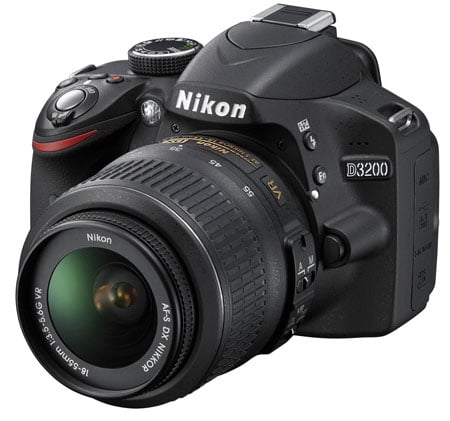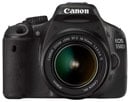Nikon D3200 review
-
-
Written by Ken McMahon
Verdict
With a huge leap that almost doubles the resolution of its predecessor, the 24 Megapixel Nikon D3200 becomes the highest resolution DX body in Nikon’s DSLR range. For its entry-level offering that’s quite a bold statement from Nikon and one that puts the D3200 at the top of the budget DSLR pile in terms of resolution at least. Canon’s budget 12 Megapixel EOS T3 / 1100D looks anemic by comparison and for the same sensor on a Sony camera you need to look to expensive range-topping models like the NEX-7 and SLT-A77 or A65.
It’s not just about sensor resolution, the D3200 has a new Expeed 3 processor which provides improved 4fps continuous shooting despite the larger file sizes. Its screen has been upgraded with an increase in resolution to 921k dots and in terms of video recording it’s now a much more versatile camera with new 1080p24/25/30 modes, enhanced exposure control, manual control over audio levels and an external mic socket.
The D3200 is a much better connected camera than it’s predecessor. Front and back IR remote sensors have been re-introduced and a new Wu-1a optional wireless mobile adapter allows you to remote control the camera and transmit images using an Android handset (an iOS version is in the works); check back for a review of this in the future.
The sensor aside though, the D3200 marks an evolutionary, rather than revolutionary advance in consumer DSLR technology, building on what was already a very capable model, the D3100, with additions and enhancements that will strengthen its appeal among those trading up to a DSLR as well as more experienced photographers looking for a high resolution DX body with outstanding video performance at a bargain price. That said, it’s annoying Nikon still hasn’t addressed three features lacking on the D3100 which remain unavailable here on the latest model: auto exposure bracketing, live histograms or an optical depth-of-field preview. Now let’s make one last comparison with its rival from Canon before wrapping-up the review.
 |
Compared to Canon EOS Rebel T2i / 550D
At the time of writing, Canon hadn’t released a new budget DSLR for 2012, leaving me to compare the D3200 to some older options. If we’re talking true entry level, the most obvious competitor for the Nikon D3200 should be Canon’s budget model, the EOS T3 / 1100D, but Nikon’s policy of upping the ante with entry level models that offer an enhanced feature set at a slighly higher price makes the older T2i / 550D a more logical contender for that role.
Externally, these are two very similar looking cameras with quite closely matched physical handling characteristics and build quality. The T2i / 550D’s viewfinder is marginally bigger and brighter, but both are pentamirror systems and there’s not a great deal of difference in practice. The D3200’s new screen is almost on a par resolution-wise with the T2i / 550D’s but doesn’t look quite as detailed as the 3:2 proportions of the Canon screen make it look bigger, with still images filling the entire area.
Nikon is probably hoping that everything else will fade into the background when buyers see the 24 Megapixel resolution and do the simple maths when comparing it with 18, 16 and 12 Megapixel models of the low and mid range models from Canon, Sony and others. But how much of a difference does this actually make? At least on the default settings, Nikon seems to have been unable to squeeze the same quality and noise performance from the sensor as Sony has on the NEX-7 and compared with the EOS T2i / 550D the D3200 also came a close second. If you make large prints that might be a compromise you’re happy with, if not, the higher resolution of the D3200 has nothing to offer you and a lower resolution mid-range mode like the T2i / 550D might be a more considered choice.
For movie makers, the D3200 is a much more capable camera than its predecessor and it has a couple of features the T2i / 550D lacks. The additional 1080p/24/25/30 modes put it on a par with the T2i / 550D as does the new external mic socket. And with built in stereo audio level meters as well as manual control of audio levels, the D3200 provides audio recording features that better those of the T2i / 550D as well as mid-range Nikon models like the D5100. The D3200 also inherits the Full-time-servo AF mode of it’s predecessor, but in most circumstances it’s more of a hindrance than a help and it’s not difficult to see why Canon hasn’t bothered with it.
The ability to plug-in the GPS module or the Wu-1a optional wireless mobile adapter may be a deciding factor for gadget fans but, to return to handling, the D3200’s Guide mode is much more likely to be of use to first time DSLR users. As it stands it makes the D3200 a much more accessible camera than the T2i / 550D, it’s a shame that once you dispense with it, the D3200’s unaided menu system isn’t nearly so user-friendly, and those who know their way around will find the Canon more manageable in this respect. It’s also worth noting the T2i / 550D features AEB, a live histogram and an optical depth-of-field preview, all sorely absent on the D3200. So even at two years older than the D3200, the T2i / 550D remains a key contender.
See my Canon EOS T2i / 550D review for more details.
Nikon 3200D final verdict
With its predecessor, the D3100, Nikon pushed both the price and feature set of its entry-level DSLR a notch above what was available from the competition, most notably Canon. The D3200 increases both of thoses gaps, costing around forty percent more than Canon’s EOS T3 / 1100D, but offering so much more that its closest rival is really the upper entry-level T2i / 550D.
So if you’re looking for a truly budget DSLR, the Nikon D3200 isn’t it; there are cheaper models out there, including the D3100 which is still available and could prove a bargain if a high resolution sensor, improved movie modes and connectivity aren’t high on your list of priorities – see opposite price and my Nikon D3100 review for more details.
But if it’s not a budget model, who exactly is the D3200 for? You could almost define a new ‘entry-level plus’ category for the D3200. It goes beyond what we’ve traditionally come to expect from an entry-level DSLR with more features including a high resolution sensor and Full HD video with manual exposure control and advanced audio features. Add to that the novice-friendly Guide mode not to mention the option to remote control it with a smartphone, and it’s a compelling choice for advancing beginners with a little more to spend.
Features missing that you could expect from a mid-range model include a bigger brighter optical viewfinder, faster continuous shooting, auto exposure bracketing, an optical depth-of-field preview, live histogram and a focusing motor to drive older non-AF-S lenses. Not everyone who wants an inexpensive DSLR needs those kinds of features though, and Nikon has a track record of accurately predicting what customers want. The D3200 will undoubtedly build on the success enjoyed by it’s predecessors and not just because of it’s headline-grabbing resolution. Like the D3100 before it, it remains an excellent choice for discerning beginners with a little more to spend and throughly deserving of a Cameralabs Highly recommended award.
Bad points | Scores (relative to 2012 budget DSLRs) |
 | ||
Build quality: Image quality: Handling: Specification: Value:
Overall: |
17 / 20 17 / 20 16 / 20 18 / 20 16 / 20
84% | |||





